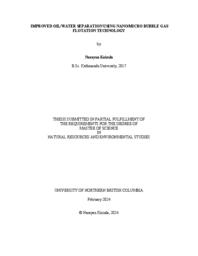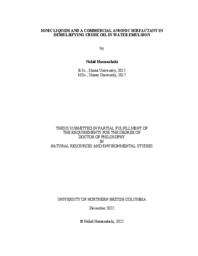Linklater, Natalie
Person Preferred Name
Natalie Linklater
Related Works
Content type
Digital Document
Origin Information
Content type
Digital Document
Origin Information
Content type
Digital Document
Description / Synopsis
This research investigated the performance of nanobubble and microbubble (NB/MB) gas flotation technology in treating oily wastewater generated after oil spill response operations. The study comprised three distinct sets of experiments. In the initial set of experiments, experiments were conducted to examine the impact of reactor configuration on the NB/MB gas flotation process. Three different reactor configurations were employed, varying in height-to-diameter ratios of 10, 20, and 30. The results indicated that reactor configuration slightly affected system performance, with gradual improvement observed as the height-to-diameter ratio increased. Following the analysis of reactor configuration, response surface methodology (RSM) was utilized to design experiments focusing on three key factors: initial oil concentration, gravity settling time and flotation time. The purpose was to analyze their impacts on oil/water separation performance and the interactions among these factors. Additionally, introducing gravity separation prior to NB/MB gas flotation aimed to assess whether allowing collected oily wastewater to settle in containers on barges would accelerate oil/water separation compared to exclusively relying on NB/MB gas flotation without gravity settling. The results from the experiment demonstrated a strong agreement between the predicted and experimental data for oil/water separation efficiency, as indicated by a high R2 value of 0.99 and an adjusted R2 value of 0.98. The predicted R² value was 0.91. Subsequently, additional single-factor experiments were conducted to determine the maximum oil/water separation efficiency. The findings revealed that an oil/water separation efficiency of 98.8% was achieved under the optimum experimental condition with the initial oil concentration of 1995 mg/L, the gravity settling time of 45 minutes and the flotation time of 38 minutes. Likewise, a second set of separate experiments was conducted after the RSM experiments to study how different levels of oil weathering affect the oil/water separation efficiency using MB and NB gas flotation. The results indicated no significant difference in oil separation efficiency between fresh and weathered oil samples. Furthermore, a third set of experiments was carried out at a pilot scale to scale up the technology and assess its feasibility. The experiments were conducted at a pilot scale (75 L). The results demonstrated a remarkable oil/water separation efficiency of 92% within one hour, surpassing gravity separation, which achieved only 4.62% over the same duration. Similarly, combining NB/MB gas flotation with adsorption achieved nearly 100% oil/water separation efficiency. Thus, the result from the experiment concludes that NB/MB gas flotation is efficient in separating oily wastewater generated after oil spills. The successful implementation of NB/MB gas flotation technology in offshore oil spill response vessels offers a promising solution with exceptional separation performance and scalability, with a minimal environmental impact, as it is a chemical-free technology.
Origin Information
Content type
Digital Document
Description / Synopsis
Crude oily wastewaters generate widely in industries and marine oil spill operations. Crude oily wastewaters contain stable oil in water emulsion (O/W), and their treatment has been challenging. Crude oil has toxic compounds for humans and the environment, and effective treatment requires meeting environmental regulations. This dissertation aimed to investigate effective and environmentally friendly demulsifiers (commercial anionic surfactant and ionic liquids) in demulsifying stable O/W emulsions. Firstly, the O/W emulsification process by ultrasonic homogenization was conducted to optimize the processing parameters and determine the required energy to generate stable emulsion, which is applicable for enhancing crude oil demulsification. The optimum condition to generate stable emulsion was at a power level of 76–80 W, sonication time of 16 min, water salinity of 15 g/L NaCl, and pH of 8.3, which required 60−70 kJ energy. Secondly, the commercial anionic surfactant showed high efficiency (99%) in demulsifying O/W emulsion at the concentration of 900 mg/L in a short shaking time (15 min) at room temperature (25 °C). It could reduce the total extractable petroleum hydrocarbons in the separated water to <10 mg/L without gravity separation and achieve promising demulsification performance at high salinity (36 g/L) and various fresh and weathered oil concentrations. Thirdly, ionic liquid with hydroxyl functional groups on the side chains effectively demulsified O/W emulsion (92%) stabilized by natural emulsifiers (e.g., asphaltenes) at a low concentration (25 mg/L) and room temperature without settling. Hence, the hydroxyl functional group is a suitable substitution for the alkyl group on the ionic liquids side chains to reduce ionic liquid toxicity. It was also found that its potency was highly affected by the emulsion type (stabilized by natural emulsifiers+Tween 20), in which demulsification efficiency reached 61% at the ionic liquid concentration of 50 mg/L and the demulsification temperature of 50 °C at 90 min gravity separation settling time. This indicated the synergistic interaction of natural emulsifiers and Tween 20 and the formation of thicker film at the oilwater interface, which affected the ionic liquid performance. Finally, comparing the performance of three ammonium-based ionic liquids with a distinct side chain (alkyl, ester, and amide) in demulsifying O/W emulsion, it was found that ionic liquid’s side chain and hydrophilicity greatly influenced their performance in the demulsifying O/W emulsion. Substitution of the hydrophobic alkyl group with the hydrophilic amide or ester groups to reduce ionic liquid toxicity improved the ionic liquid potency in the demulsifying emulsion. Ionic liquid with the amide group on the side chain resulted in the highest demulsification efficiency (94%) compared to ionic liquids with the ester (91%) and alkyl (88%) groups at the ionic liquid concentration of 25 mg/L and settling time of 15 min at room temperature, indicating the superiority of the amide group in the demulsifying O/W emulsion.
Origin Information
Content type
Digital Document
Description / Synopsis
Shortage of clean drinking water is a serious problem faced by the world at present times, with water borne diseases claiming 5 million deaths globally each year. Many methods are available to treat contaminated drinking water; however, cultural, economic, and social factors often impair implementation of these methods, particularly in developing countries. Moringa and ginger root powders appear to offer a promising alternative to treat contaminated drinking water. This study examines the nutrient composition of Moringa and ginger roots and determine their antibacterial efficacy against Escherichia coli (E. coli). After growing Moringa and ginger plants in a greenhouse for seven months and three years respectively, their roots were harvested, dried, powdered and analysed for their chemical composition using ICP-MS and Elemental analysis. The most abundant metal found in both the root powders was potassium, while calcium, magnesium, sulphur, sodium, and phosphorus were other elements present in high amounts. However, the concentration of these metals in Moringa and ginger root powders varied significantly. The abundance of essential elements in the two root powders justifies their use as a point-of-use water treatment method. For both Moringa and ginger root powders, 1400 mg/L concentration was determined to be the most effective concentration as it reduced E. coli in contaminated water by 88.66% and 62.63% respectively. The combination of the two root powders appeared to have a synergistic effect on E. coli as Moringa and ginger root powders combined in 1:1 ratio reduced bacterial counts by 94.78% when added to the contaminated water at 2000 mg/L.
Origin Information





